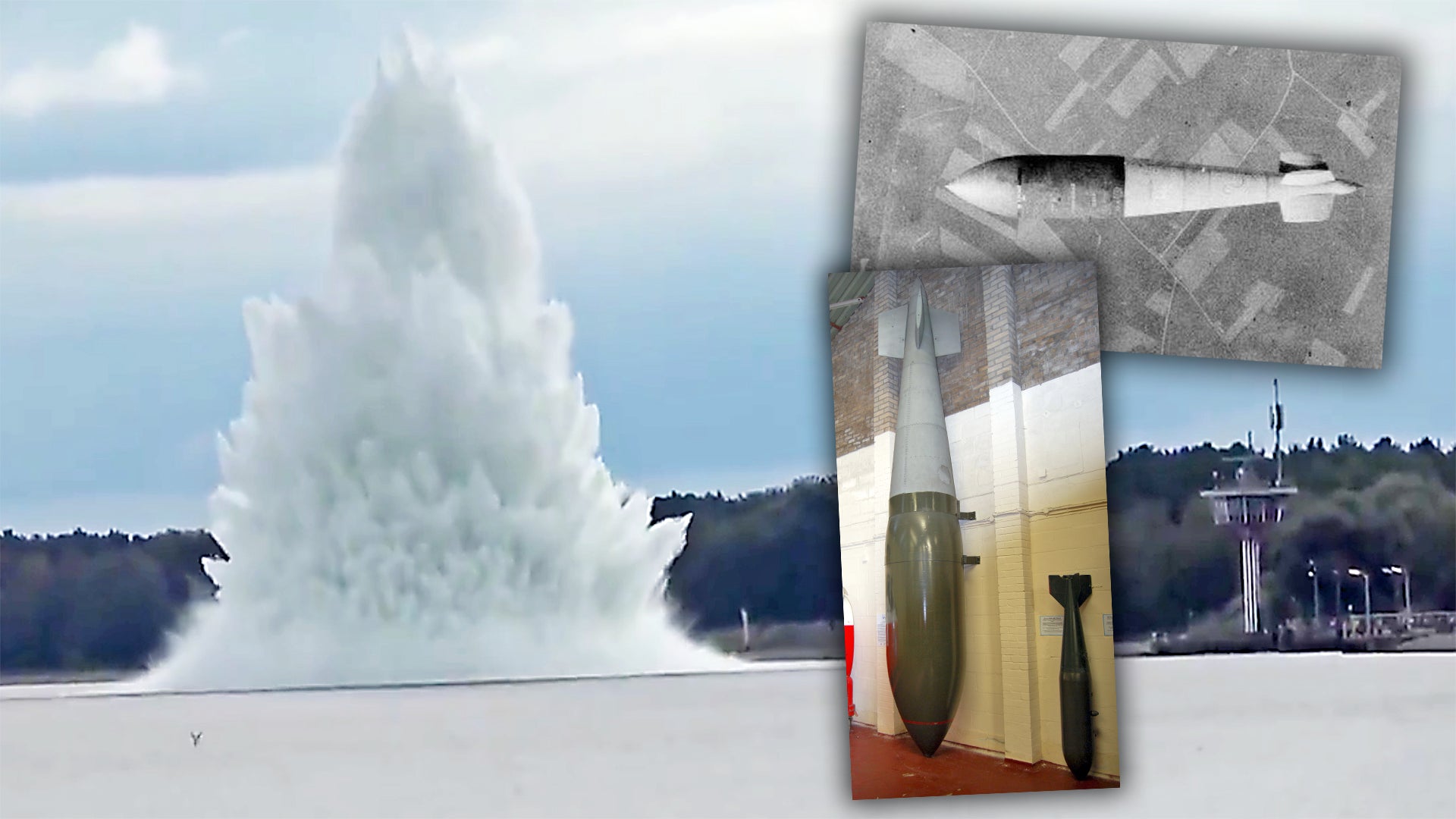A British Royal Air Force “Tallboy” bomb, intended to sink a German cruiser during World War Two, blew up spectacularly in a Polish canal while divers were working to defuse it. After lying dormant for 75 years, the 12,000-pound bomb exploded underwater, sending a huge column of water skywards, but fortunately not resulting in any injuries or serious damage.
Polish Navy demolition experts were in the process of trying to make the 21-foot bomb safe by a process of deflagration, meaning that, using a remote device, the weapon was being exposed to heat to burn away the explosives.
According to reports, the bomb had been buried in mud 39 feet below the waterline with only its nose remaining visible. A controlled explosion had earlier been ruled out due to the risk of damaging a nearby bridge.
As it is, the effort to make the “Tallboy” safe has been described in local media as the largest underwater bomb disposal operation ever to take place in Europe, and required around a year of planning and preparation.
“The deflagration process turned into detonation,” the Polish Navy’s Second Lieutenant Commander Grzegorz Lewandowski was quoted as saying by Polish state-run news agency PAP. “The object can be considered as neutralized, it will not pose any more threat,” he added.

The shockwave from the detonation of what remained of the bomb’s 5,200 pounds of Torpex explosive filling rapidly engulfed the channel, demonstrating how the weapon’s “earthquake” effect was designed to destroy targets even without scoring a direct hit.
At the time of the detonation, on October 13, 2020, the divers were at a safe distance from the bomb, while more than 750 civilians had been evacuated from an area within a 1.6-mile radius, close to the town of Swinoujscie in northwest Poland.
This particular “Tallboy,” a weapon that was carried operationally only by the Avro Lancaster four-engine heavy bomber, had originally been directed against the German Kriegsmarine cruiser Lützow, anchored in the Piast Canal that connects the Bay of Szczecin with the Baltic Sea, in what was then Germany. Although fitted with three detonators, for some reason, the bomb had failed to explode.

On April 13, 1945, a force of 24 Lancasters targeted the heavy cruiser Lützow and sister warship Prinz Eugen, but the raid was hampered by heavy cloud cover. Two days later the bombers returned, again without success. Finally, on April 16, Lancasters scored several “Tallboy” near-misses — some sources also claim a direct hit — on Lützow, and the cruiser foundered in shallow water. With the warship’s guns still operational, Lützow saw out the war as an anti-aircraft battery before being captured by the Soviets.
Original footage from the RAF attack on the Lützow can be seen from around the 0:52-minute mark in this video:


The “Tallboy” in question was finally discovered in September 2019 during work to deepen the channel to improve access to the Polish port of Szczecin.
The heavyweight weapon was designed by British engineer Barnes Wallis, who was also responsible for the “bouncing bomb” used by the RAF in the raid against the dams in Germany’s Ruhr Valley during World War Two. The “Tallboy” was a deep-penetration weapon with a streamlined shape to ensure near-supersonic speed at the point of impact. After the success of the “Tallboy,” Wallis enlarged the design still further, to produce the colossal 22,000-pound “Grand Slam,” also designed for deep penetration.

The “Tallboy” was first used by Lancasters of No 617 Squadron, the “Dambusters,” on the night of June 8/9, 1944, against the Saumur railway tunnel in Normandy, France, a critical route for transporting German reinforcements toward where the Allies had conducted the D-Day landings just days earlier. The weapon also saw notable use against hardened German U-boat pens and at least one example was used to strike Hitler’s mountain retreat at Berchtesgaden in Bavaria, Germany. Other major operations involving the weapon included the sinking of the German battleship Tirpitz, anchored in a Norwegian fjord. By the end of the war, a total of 854 “Tallboys” had been dropped.
Polish authorities claim that the example found near Swinoujscie was the largest unexploded World War Two bomb ever found in Poland, and this seems likely. The RAF employed the biggest freefall bombs in the Western European theater of operations and the only one to exceed the weight of the “Tallboy” was the “Grand Slam.” There’s no record of that weapon having been used on targets in what is now Poland.
As one of the most bombed countries during World War Two, it’s not surprising that Poland still plays host to unexploded munitions, although a “Tallboy” bomb is a genuine rarity. Bearing in mind its destructive power, we should be thankful that the Polish Navy took all the right precautions to ensure that, when things didn’t go quite as planned, no injuries occurred as a result.
Contact the author: thomas@thedrive.com
